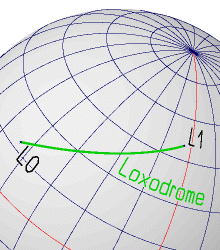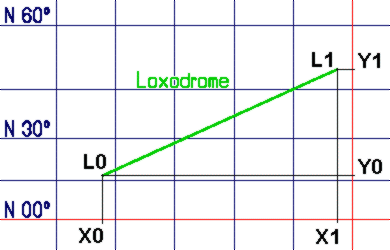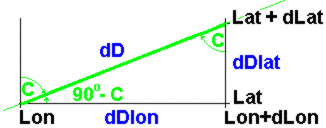Notes on Loxodrome Calculations
In navigation, commonly tracks of constant course (constant heading)
are sailed or planned. A track of constant course is a line making
the same angle with all meridians and can readily be steered using a compass.
Such a line of constant heading is called a rhumb line or loxodrome. 1 nautical mile = 1/60 degrees Furthermore, it is assumed that angles as well as the arguments of the trigonometric functions are expressed in degrees. Consequently, the results of the inverse trigonometric functions will be degrees. The Loxodrome Equation in the Mercator Projection
For finding the equation of a loxodrome connecting two arbitrary points
on the surface of the Earth, the location of the two points may be transferred
onto a Mercator grid. A straight line connecting the two points in the Mercator
grid represents the loxodrome and the angle under which this straight line
intersects with a vertical line (Meridian) is the true course for this rhumb line. Location L0: (Lat0, Lon0) Location L1: (Lat1, Lon1) The Mercator transformation maps these points onto a plane (X,Y) Mercator grid: Location L0: X0 = Lon0; Y0 = ln( tan(Lat0/2+45°) ) * 57.2958 Location L1: X1 = Lon1; Y1 = ln( tan(Lat1/2+45°) ) * 57.2958 The factor "57.2958" is a scaling factor to assure conformality. It is determined by 180°/PI = 57.2958 °/rad. This scaling of the Latitude axis assures that - on the Equator - the distance of one degree of Latitude equals the distance of one degree of Longitude.
A straight line from (X0,Y0) to (X1,Y1) is the Loxodrome, connecting the locations L0 and L1. The general equation of a line connecting two points (x0,y0) and (x1,y1) in a two-dimensional (x,y) space is given by: (y -y0) = (x -x0) or y = (y1-y0) * (x-x0) + y0 (y1-y0) (x1-x0) (x1-x0) Applying this for the two points of the loxodrome (X0,Y0) and (X1,Y1), the equation for the loxodrome in the plane Mercator grid is given by: Y = (Y1-Y0) * (x-X0) + Y0
(X1-X0)
Filling in the Mercator transformed values (X0,Y0) and (Y1,Y1) for the locations L0 and L1, yields the equation of the Loxodrome in the Mercator plane: Y = 57.2958 * ( [ ln(tan(Lat1/2+45°)/tan(Lat0/2+45°)) ] + ln(tan(Lat0/2+45°)) )
[ (Lon1-Lon0) ]
Loxodrome CourseIn the Mercator projection, the loxodrome is a straight line. The angle of intersection of the rhumb line with a vertical line is the true course C of the rhumb line and is given by:
Loxodrome Distance
Also the distance along a loxodrome can be determined analytically.
However, distances cannot be taken from the Mercator grid representation.
This is because the "scale" of a Mercator chart depends on the Latitude, which is
the "trick" to obtain parallel meridians in Mercator charts. distance_of_one_degree_EastWest = cos(Lat) * distance_of_one_degree_NorthSouth
These infinitesimal distance components dDlon and dDlat correspond to a small change of Longitude (dLon) and Latitude (dLat) respectively:
The distance components dDlon and dDlat are related to each other by the course angle:
Eliminating dDlon from (2) using (5) and expressing the result in change of Latitude yields:
This identity has to be integrated beween Lat0 and Lat1 to obtain the total distance D of the loxodrome (notice that cos(C) is a constant for a loxodrome):
The above equation is undefined for C=90° or C=270°.
This is the case if L0 and L1 have the same Latitude (Lat0=Lat1)
and equation (7) yields D = 0/0, which is undefined. dD = dDlon / sin(C) = dLon * cos(Lat) / sin(C) For a constant latitude (since C=90° / 270° ) this equation can be
integrated between the Lon0 and Lon1:
Notice that distances are always positive, so only the absolute value of D matters.
Loxodrome Destination or the "Dead-Reckoning Problem"
The dead-reckoning problem is formulated as finding the current (estimated) position L1 (Lat1, Lon1),
given a distance D sailed at a constant course C from a known location L0 (Lat0, Lon0).
From the basic Equations (3), (4) and (5), describing how dDlon, dDlat, dLat and dLon are related, the following can be derived:
Integrating both sides of the above differential equation yields:
this can be elaborated using the following equation:
For the change in Longitude and the corresponding change in Latitude, this yields:
Again, the scaling factor 57.2958 (180°/PI) assures the conformality while using angles expressed in degrees instead of radians.
The value for "Lat1" is derived from equation (9).
This solution is conform to solving the values of Lat1 and Lon1 from the identities (1), (7) and (8). | ||||||||||||||||||||||||||||||||||||||||||||||||||||||||||||||||||||||||||||||||||||||||
| Cover << Sail Away << Terms and Conventions << . | last updated: 22-Feb-2005 |


